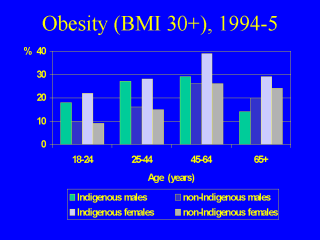|
|
|
|
front |1 |2 |3 |4 |5 |6 |7 |8 |9 |10 |11 |12 |13 |14 |15 |16 |17 |18 |19 |20 |21 |22 |23 |24 |25 |26 |27 |28 |29 |30 |31 |32 |33 |34 |review |
 |
Indigenous adults are more likely than non-Indigenous adults to be classified as obese, based on their measured height and weight. The difference is more pronounced among those less than 45 years old than among older adults. Data for Indigenous adults is from the 1994 National Aboriginal and Torres Strait Islander Survey. Data for non-Indigenous adults is from the 1995 National Nutrition Survey, which consisted of a sub-sample of respondents from the 1995 National Health Survey. No measurements of height or weight were taken in the National Health Survey, and self-reports were found to under-estimate body mass index among those measured in the National Nutrition Survey. The figures in the graph show body mass index based on actual measurements of height and weight, rather than on self-report. For more information about overweight and obesity among Indigenous Australians, see Cunningham J & Mackerras D, 1998, Occasional Paper: Overweight and Obesity, Indigenous Australians, 1994. ABS cat. no. 4702.0, Australian Bureau of Statistics, Canberra. Available on-line at http://www.abs.gov.au/Ausstats/ ABS%40.nsf/525a1b940214123 5ca25682000146abc/0160129f31 7b8611ca2568890020a6f1!Open Document BMI Body mass index
|